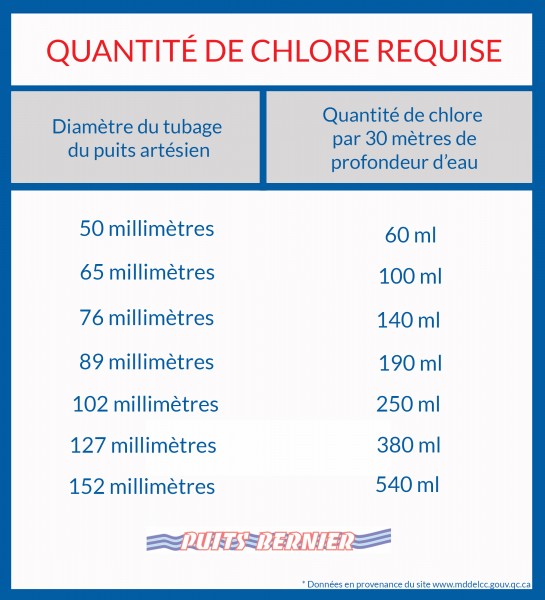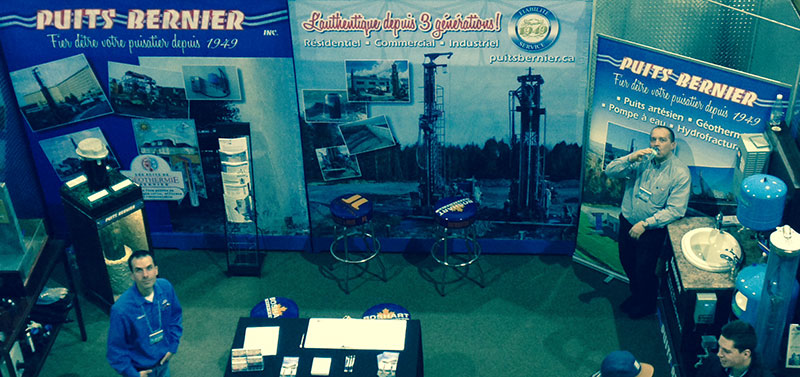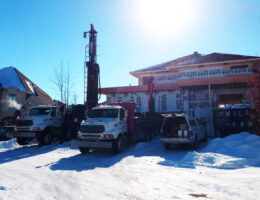Gatineau
Use a geothermic drilling system in the wonderful city of Gatineau in Outaouais. We have, as usual, worked carefully to limit damage to the land at this residence.
Matane
Establishing a geothermic drill in Matane, Bas-St-Laurent. A depth of 500 feet was necessary for this residence, which will experience constant temperatures year-round from now on.
How to chlorinate your well
You can easily and inexpensively disinfect your well and plumbing system yourself by using a chlorine solution. This process is called “chlorination”. It consists of flushing your well and plumbing system with a chlorine solution that will kill bacteria and other micro-organisms (see the table below for the quantities). It is generally recommended to carry out this process every 6 months.
The disinfection of your well with chlorine is a very effective method to eliminate bacterial contamination. Follow these steps:
- Set aside a reserve of water as necessary, because you will not be able consume your well water for a period of 12 hours.
- Set your water softener to “bypass”.
- Remove the cover from the artesian well.
- Pour the recommended quantity of bleach into your well water (see the table below for the quantities).
- Connect a garden hose to an outdoor faucet of the house and bring the other end of the hose to the well in order to create a closed circuit.
- Open the outdoor faucet and let the water run for about two hours in order to thoroughly mix the bleach with your well water.
- Remove the end of the garden hose from the well and replace the cover.
- Open only the cold water faucets inside the house one by one and let them run until you can smell the chlorine. This typically takes no more than 2 or 3 minutes. Don’t worry if your water changes color.
- Close the faucets.
- Let the system rest for 12 hours without using your water.
- Drain the well using your outdoor garden hose. Don’t forget that this water contains chlorine, so don’t let it run toward your flower beds or other places that could be affected by chlorine.
- Let the water run until there is no more smell of chlorine. If the water flow from your well is low, adjust the faucet to avoid draining your well completely or perform this step over a period of several days.
- Close the outdoor faucet.
- Open the cold water faucets inside the house one by one until there is no more smell of chlorine.
- Start up the water softener.
- Analyze the water 1 week after chlorination.
If you need additional information about chlorination, you can contact our specialists at any time. They will be happy to provide specific advice for your well.

You can consult the Quebec government website for more information and use their tool to calculate the quantities required for the disinfection of a well.
Your artesian well maintenance
Artesian wells do not generally require much maintenance. However, pay attention to any changes that may occur to water quality. The color, texture, taste, or smell may have changed and signify the presence of bacteria in the water… or not! Your water can have an unusual smell to it while being entirely drinkable. Do not however wait for the water to deteriorate to this point before acting!
You can from time to time check the following points to ensure water quality:
- The absence of animals or dead leaves around your well
- The absence of debris on the water surface in the well
- The absence of stagnant water close to your well
- The absence of punctures in the pipes that might let surface water or residue enter your well
- The blow-hole is clear of any obstruction
- Avoid any liquid or rubbish to be drained into the well
- Do not use pesticides or fertilizer on the land in the area close to the well
- Avoid flushing chemical products such as oil, solvants, paint, etc. down the toilets
We recommend a twice a year chlorination of the well to avoid bacteria developing in it. We also recommend that you have the water tested at least once a year by a certified laboratory, since bacteria can be present in the water without any obvious signs.
Keep in mind however that water analysis alone does not guarantee the quality of your drinking water. Besides the analyses, you hava to regularly check on the points mentioned above and correct any deficiency as needed.
For any questions regarding your artesian well, contact us and our team will be more than happy to answer your query.

Quebec
Drilling of an artesian well for this residence in Quebec City. The well provide the main house, but also the adjacent farm.
Reducing your daily water consumption
Since water is a precious resource, here are 23 tips to help you reduce water consumption in your daily life.
In the Kitchen
- Repair leaky faucets.
- Wait until your dishwasher is completely full before running it.
- Don’t rinse your dishes too much before putting them in the dishwasher.
- If you wash your dishes by hand, use a tub instead of running water.
- Turn off the faucet between soaping and rinsing your hands.
- Do you prefer to drink you water very cold? Fill a pitcher and put it in the refrigerator to chill.
- Wash your vegetables with a brush instead of wasting the excess water that runs over them.
In the Bathroom
- Here too, repair leaky faucets.
- If you have a constant pressure controller, the system will warn you if your toilet is leaking.
- Purchase a low-flow toilet and showerhead when you need to replace yours.
- Turn off the faucet while you are washing your hands, shaving or brushing your teeth.
- Take quick showers instead of baths. To save even more water, turn off the water while you are soaping up.
- Don’t use the toilet as a garbage can.
- As with the dishwasher, wait until the washing machine is full before doing a load.
Outdoors
- Water your garden in the evening. This will keep around 50% of the water from evaporating.
- Use rainwater to water your garden.
- Use mulch in your garden, this helps retain moisture.
- Don’t water your driveway! Use a broom when you need to.
- Don’t cut your lawn too short. Longer grass retains moisture and will prevent you from needing to water it.
- Redirect water from the gutters to flowerbeds or the lawn.
- Use a bucket of water instead of a hose to wash your car.
- Cover the pool with a tarp in order to prevent evaporation.
- In order to reduce splashing, don’t fill your pool to more than 20 cm below the edge.
Paper
- Since it takes 26,000 liters of water produce a ton of paper, don’t forget to recycle.

New regulations for wells and geothermal heating
On the 2nd of March 2015, new regulations and changes concerning the installation of artesian wells and the drilling of geothermal systems will come into force. Here are some of the changes that you should know about.
Overseen by an accredited professional
Your artesian well must still be at least 15 meters from your septic tank. This regulation has not changed. However, in the event that your artesian well is drilled more than 15 meters but less than 30 meters from your septic tank, you will now be required to have your well sealed by a certified professional, such as an engineer or a technician.
Permit required
Do you want to make substantial changes to your well? Please note that some of these changes, such as deepening your well, fracturing it, or sealing it, will henceforth require a permit.
Water analysis is not required
In the past, after drilling a new artesian well you were required to conduct a water analysis and send it to the appropriate department. The law no longer requires you to carry out this analysis. However we strongly recommend that you conduct this analysis, for your own peace of mind and to ensure that you will not suffer any health problems resulting from poor water quality.
Ditto for geothermal energy
Your open-loop geothermal system must conform to the same standards as your water withdrawal facility, with any necessary adaptations.
Methanol is not allowed
Previously, methanol was permitted in the pipes of closed-loop geothermal systems. Use of this toxic chemical is now prohibited, as it is harmful to the environment and potentially dangerous for your health in the event of breakage. At Bernier Wells, we have long preferred propylene glycol, which is known to be non-health threatening.
Accessible facilities
In conclusion, do not forget that your facilities must remain accessible at all times. For example, building stone walls around your well to conceal it is not permitted. Inspections, maintenance, disinfection, or repairs may be necessary and it must be possible to carry these out without compromising accessibility. Therefore, accessibility of wells is now required under the new regulations.
For more information about all the regulations applicable to your facilities, consult this document.

A hard winter for wells
This February, because of the intense cold we’ve been experiencing this winter, the frost has already reached a depth of over one and a half meters. So what are the consequences? Firstly, there is a risk that the water of your surface well, which is drawn from a point very close to ground level, will freeze, leaving you without water.
Secondly, you may even experience water freezing problems with an artesian well, and this is because of your pipes. These temperatures will be the norm from now on according to Environment Canada, so here are some tips to help you avoid this annoying situation.
- When excavating your well, bury your pipes deeply. To keep costs down, some people prefer to bury their pipes at the surface. Be aware that you won’t be saving money if you need to bring in a specialist team each winter to thaw frozen water.
- Ensure your pipes are insulated. By insulating them with a layer of expanded polystyrene for example, your pipes will be well protected against frost. Here again, the cost of installation will be higher, but you will be saving on maintenance costs in the long run.
- Install heating cables inside and around your pipes. Though a more expensive option, they are very effective. The cables operate via a thermostat, coming on only when required.
Don’t forget that prevention is better than cure. It is a major inconvenience to be without water, and water freezing in the pipes can also cause damage, which will need to be repaired, or even lead to some components having to be replaced.
If freezing water is causing problems with your well, get in touch with us and we will help you find the best solution for your situation.

Tradeshows 2015
Three exhibitions have been scheduled this year for you to meet the Puits Bernier team, so we can show you our expertise and all our products and services.
Expo Habitat Estrie – 5th to 8th of February
The Estrie Home Show, which will take place at the Sherbrooke Exhibition Center again this year, is happy to count on Michael and his team as exhibitor. You shouldn’t miss this if you want to meet the biggest number of home professionals in just one place! You’ll find us at kiosk 222.
Expo Habitat Québec – 18th to 22nd of February
Your welldigger will finish their exhibition season in the beautiful city of Quebec with this home show that will take place in its Centre de foire – ExpoCité. It’s an opportunity for you to find out more about how things are done and how to do them even better in different parts of the home. Come and meet us at kiosks 425-426 to talk to us about wells, drilling and geothermics.
Salon National de l’Habitation – 6th to 15th of March
This year, for the very first time, the Puits Bernier team will be present at this show, which is being held at Place Bonaventure in Montreal for its 36th edition. You will be able to meet two specialist organizations under the same roof at the event: our team members are going to have the privilege of sharing kiosk #1249 with Géothermie Boréale. This is the final show in our excellent season of exhibitions!
It’ll be a pleasure to see you at one of these exhibitions. Don’t hesitate to contact us at 1 (800) 230-9017.

Sutton
Drilling for artesians wells and geothermal wells for this house in Sutton.




